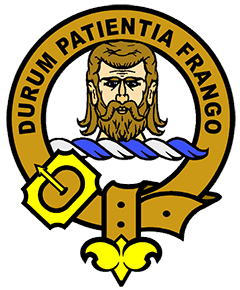Muir Clan
Muir Clan Crest: A savage's head, couped, Proper.
Muir Clan Motto: Durum Patientia Frango (I overcome difficulty by patience).
Muir Clan History: The surname is descriptive of living beside a moor, or heathland, although some say that it denotes size, the Gaelic for “large” being “mor.” A Thomas de la More was executor of the Will of Dervorguilla de Balliol, mother of King John Bailliol, in 1291, and several of the name rendered homage to Edward I in 1296.
The Mures of Rowallan in Ayrshire were the Chiefly House, but their lands were seized by the Comyns during the reign of Alexander III. After the Battle of Largs in 1263, however, they were restored. Gilchrist Mure was not only knighted for his valour, but married a Comyn daughter.
Archibald, their eldest son was killed at the Siege of Berwick. However, his son, William, was knighted by David II and, in 1346, Sir William's granddaughter, Elizabeth Mure, married Robert II by Papal Dispensation to legitimise their previously born children.
In the 15th century, the Mures fought for James IV at the Battle of Flodden, and supported Mary Queen of Scots during her minority. As reformed Protestants, however, they soon found themselves in opposition to her party and, in the century that followed, were persecuted for being Covenanters. For allowing meetings to be held at Rowallan, William Mure of Rowallan was imprisoned at Stirling, then Edinburgh. From this, it appears, the Chiefly line did not recover and, with the Rowallan estates subsequently passing to the Campbell earls of Loudon, large numbers of the family emigrated to the USA, Canada and Australia.
Sir William Mure of Rowallan (1594-1657) wrote The True Crucefixe for True Catholikes. Thomas Muir of Huntershill (1765-99) was born in Glasgow, the son of a hop merchant. For advocating political reform, he was transported to Botany Bay. John Muir (1838 – 1914) was born in Dunbar and emigrated to America with his parents at the age of eleven. His subsequent writings and philosophy were a major influence on the environmental movement. Edwin Muir (1887-1959) was born on Orkney, then moved to Glasgow where he soon became established as one of Scotland's most significant poets. Sir William Muir (1819-1905) became Foreign Secretary to the Indian Government in 1865. John Muir (1810-82), brother of Sir William, was a Scottish sanscrit scholar who founded a Chair at Edinburgh University.
Thomas Muir (1765-1799), 18th Century radical Lawyer now considered by many to be the "father of Scottish democracy". Muir's campaigning for political reform led to his arrest for seditious acts in 1793. Despite having the opportunity to flee to America, he chose to face his accusers and spread the message of political reform. His show trial took place in Edinburgh, presided over by the infamously conservative judge, Lord Braxfield, the Lord Justice Clerk, four other judges, and a rigged jury made up entirely of establishment supporters. The inevitable guilty verdict imposed by this kangaroo court resulted in Muir being given a 14 year sentence in the Australian Penal Colony. At his trial, Muir told the jury which convicted him that 'the impartial voice of future times will rejudge your verdict.'
Surname distribution in Scotland: The Muir name is most commonly found in the Orkney Islands, Ayrshire, Renfrewshire, Argyll and Bute and Dumfies and Galloway.
Places of Interest: Although considerably enlarged and modernised, Rowallan Castle, Kilmaurs, Ayrshire, dates from the 13th century when it was the home of the Mure family. It was, presumably, the birthplace of Elizabeth Mure, wife of Robert II, but ownership passed to the Boyles, the Campbells of Loudon, and the Corbetts, who became barons Rowallan. Cloncaird Castle, south east of Ayr, was built by Walter Muir in the 16th century, but passed to the Wallaces, then to an Ayrshire businessman. The birthplace of John Muir, the Countryside Conservationist, and the John Muir Country Park, which is named after him, are at Dunbar, in East Lothian. Blair Drummond House at Stirling, today centrepiece of the Blair Drummond Safari Park and home to the Camphill Trust, was bought by the Glasgow tea merchant Sir John Kay in 1916, and passed on to his nephew Sir John Muir, Lord Provost of Glasgow. It still belongs to the Muir Family.
Clan Muir members display Prints.

